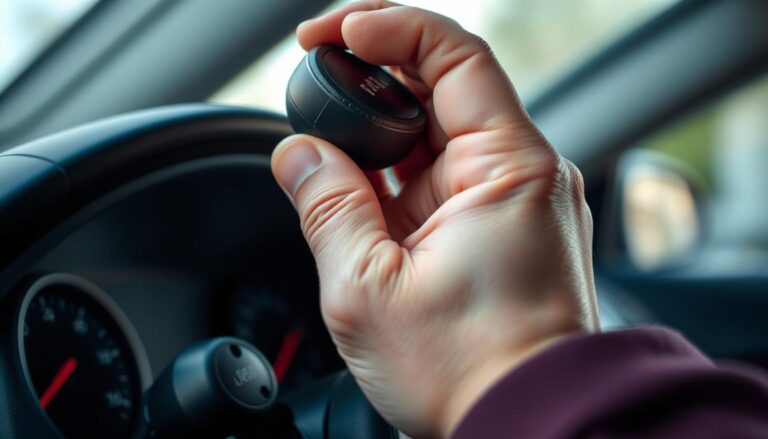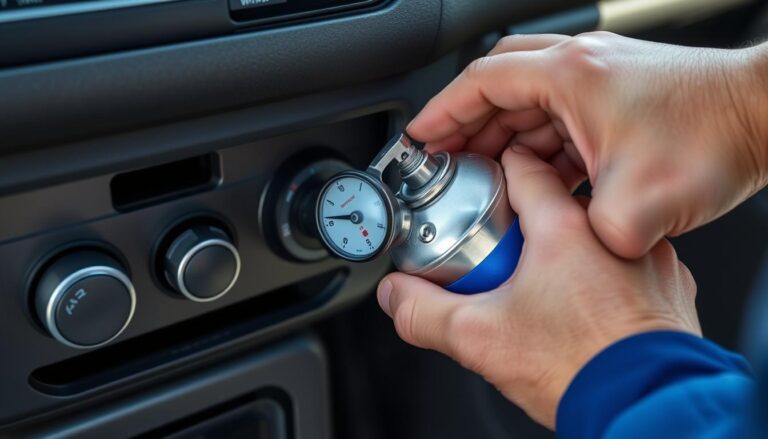A stuck seatbelt poses a significant challenge, undermining vehicular safety. The predicament of a jammed seatbelt often elicits confusion regarding its origin and rectification.
The significance of a functional seatbelt transcends mere safety; it is a legal imperative. A stuck seatbelt not only incurs inconvenience but also harbors potential hazards.
This discourse aims to elucidate the methodology for fixing seatbelt malfunctions expeditiously. Adherence to the proposed protocol will facilitate the resolution of the issue, ensuring the seatbelt’s optimal functionality.
Key Takeaways
- Identify common causes of a stuck seatbelt.
- Learn simple steps to repair a jammed seatbelt.
- Understand the importance of regular seatbelt maintenance.
- Discover when to seek professional help for seatbelt repair.
- Ensure your safety on the road with a functioning seatbelt.
Understanding Seatbelt Mechanisms and Common Issues
Seatbelts, intricate safety apparatuses, necessitate comprehension of their operational dynamics. Central to these systems is the retractor, a pivotal element facilitating the belt’s extension and retraction as circumstances dictate.
How Seatbelt Retractors Work
Seatbelt retractors are engineered to immobilize the belt during abrupt deceleration or collision, thus averting ejection of occupants. They house a spring-activated mechanism that retracts the belt during periods of inactivity. The retractor’s locking functionality is contingent upon a sensor that detects rapid deceleration or vehicle rollover.

Types of Seatbelt Malfunctions
Malfunctions encompass a spectrum of issues, including a stuck retractor, jammed or twisted belts, and malfunctions with the buckle or latch. These problems may stem from wear and tear, accidental locking, or debris obstructing the mechanism.
Safety Considerations Before DIY Repairs
Initiate repairs only after ensuring the vehicle is stationary on a level surface and the parking brake is engaged. It is imperative to refer to the vehicle’s manual for detailed instructions on seatbelt maintenance and repair. Safety must remain paramount when addressing critical safety components such as seatbelts.
Tools and Materials You’ll Need
Initiating the repair of a stuck seatbelt necessitates the compilation of requisite tools and materials. The availability of appropriate tools significantly enhances the efficiency and smoothness of the repair process.
Household Items That Can Help
Utilizing household items can facilitate the resolution of a stuck seatbelt issue. A flathead screwdriver, needle-nose pliers, and a lubricant such as WD-40 or silicone spray are indispensable. A cloth or paper towel may also be required for debris removal.
Optional Specialized Tools
While not imperative, specialized tools can prove advantageous. A seatbelt repair kit, which encompasses a replacement webbing or buckle, is beneficial for more severe damage. A torque wrench is also useful for the precise adjustment of the seatbelt retractor.
| Tool | Description | Usefulness |
|---|---|---|
| Flathead Screwdriver | General-purpose tool for prying and adjusting | High |
| Needle-Nose Pliers | Precision tool for gripping small objects | Medium |
| Lubricant (WD-40 or Silicone Spray) | Reduces friction and helps loosen stuck parts | High |
| Seatbelt Repair Kit | Includes replacement parts for seatbelt | High (for extensive damage) |

How To Fix a Seatbelt That Is Stuck in a Locked Position
Addressing a seatbelt that is in a locked position is a prevalent challenge, amenable to resolution through appropriate methodologies. Grasping the intricacies of a seatbelt’s operational mechanism is imperative for pinpointing and rectifying the problem at hand.
Identifying a Locked Retractor
The initial step towards resolving a stuck seatbelt involves ascertaining whether the retractor is in a locked state. Such a condition can arise from a multitude of causes, including abrupt deceleration, sharp maneuvers, or the natural degradation of components over time. To verify, a gentle tug on the seatbelt is advisable. Should it fail to retract or extend, it is probable that the retractor is locked.
Step-by-Step Release Method
To liberate a locked seatbelt, initiate by slowly extracting the seatbelt to its utmost extent. Subsequently, permit it to retract into its housing at a controlled pace. Repeating this action several times may alleviate any accrued tension responsible for the lock. Should this approach prove ineffective, a slight tilt of the seatbelt during its extraction might disengage the locking mechanism.
Dealing with Stubborn Mechanisms
In instances where the seatbelt remains recalcitrant despite the aforementioned release method, it is crucial to inspect for any obstructions within the mechanism. The presence of debris or dirt can impede the functioning of the seatbelt’s retractor. A thorough cleaning of the retractor and its environs may rectify the situation. Employ a soft-bristled brush or a delicate cloth to remove any impediments.
Vehicle-Specific Considerations
It is equally vital to take into account the specificities of one’s vehicle when confronting a stuck seatbelt. Variations in seatbelt mechanisms across different models necessitate a tailored approach. Consulting the vehicle’s manual or seeking professional guidance if in doubt is advisable.
By adhering to these guidelines and accounting for the unique characteristics of your vehicle’s seatbelt system, you can effectively address a stuck seatbelt issue. Should the problem persist, it is prudent to seek professional assistance to guarantee your safety on the road.
Resolving a Jammed or Twisted Seatbelt
The occurrence of a jammed or twisted seatbelt necessitates immediate attention to safeguard one’s safety during vehicular travel. Such malfunctions can stem from a multitude of causes, including misuse, degradation over time, or entrapment of foreign objects within the mechanism.
Untwisting a Tangled Seatbelt
To rectify a tangled seatbelt, initiate by fully extending the belt and conducting a thorough examination for any signs of entanglement. Subsequently, employ gentle manipulation to disentangle the belt, ensuring it remains flat. In instances where the belt is excessively knotted, a complete retraction followed by extension may be required to eliminate the tangle.
- Pull the seatbelt out fully to identify the twist.
- Gently manipulate the twisted section to straighten it.
- Retract and extend the belt again to ensure it’s properly aligned.
Removing Foreign Objects
Foreign entities such as coins, keys, or debris can precipitate a jammed seatbelt by becoming lodged within the retractor or buckle. To address this, meticulously inspect the seatbelt’s mechanism and extract any visible obstructions. Employ a soft brush or compressed air to dislodge dust or minute particles.
Fixing Belt Material Issues
Damage to the seatbelt’s material, manifesting as fraying or cuts, can impede its functionality and lead to jamming. A thorough examination of the belt for any signs of wear is imperative. Frequently, a seatbelt compromised by such damage necessitates replacement to guarantee safety.
Key steps to fix belt material issues:
- Inspect the belt for any visible damage.
- Consult a professional if you’re unsure about the extent of the damage.
- Replace the seatbelt if it’s damaged beyond repair.
Adherence to these guidelines enables the resolution of common seatbelt malfunctions, ensuring the optimal functioning of your vehicle’s safety apparatus.
Addressing Buckle and Latch Problems
Seatbelt buckles and latches often present common issues, which can be resolved through basic troubleshooting. The functionality of these mechanisms is paramount, and their malfunction can be a significant concern.
Accumulation of debris within the buckle is a prevalent problem. Cleaning Debris from Buckles is a straightforward process that can resolve many issues. Initially, inspect the buckle for any visible debris. Utilize a soft brush or compressed air to delicately remove any dirt or dust. For a more comprehensive cleaning, a damp cloth can be employed, provided the buckle is allowed to dry completely before use.
Fixing Misaligned Latches
Misaligned latches can impede the seatbelt’s functionality. To rectify this, inspect the latch for any signs of misalignment. Gently adjust the latch back into its correct position. If the latch is damaged, it may necessitate replacement.
Dealing with Stuck Release Buttons
A stuck release button can be a source of frustration, often resulting from dirt or wear. To address this, attempt cleaning around the button with a soft brush or compressed air. If the button remains stuck, consider having it inspected or replaced by a professional.
As “The importance of a properly functioning seatbelt cannot be overstated,” addressing buckle and latch problems is critical for safety. Regular maintenance can prevent many issues, ensuring your seatbelt operates smoothly when needed.
“A well-maintained seatbelt is a critical component of vehicle safety.”
When to Seek Professional Help
Confronting a recalcitrant seatbelt problem necessitates an understanding of when to enlist professional aid. While certain malfunctions can be rectified through self-repair, there exist scenarios where the expertise of a professional is imperative for your safety on the highway.
Signs of Serious Damage
Indicators of a more profound issue with your seatbelt than what can be addressed through DIY efforts include:
- Visible tears or fraying in the seatbelt material
- A buckle that cannot be unlatched
- A retractor that is completely locked and won’t release
These symptoms imply potential structural damage that necessitates professional intervention.
Warranty and Insurance Considerations
Engaging in DIY repairs on a vehicle still under warranty could potentially invalidate the warranty. Concurrently, some insurance policies may extend coverage for seatbelt repairs or replacements. It is paramount to scrutinize your warranty and insurance policy prior to undertaking any repairs.
Finding Qualified Repair Services
In pursuit of professional assistance, seek out certified mechanics or auto repair establishments with a specialization in seatbelt repairs. Investigate online reviews, solicit recommendations, and confirm their proficiency and equipment to address your seatbelt issue accurately.
Conclusion
Addressing stuck seatbelt issues is paramount for ensuring vehicular safety. This discourse has elucidated the intricacies of seatbelt mechanisms, pinpointed prevalent problems, and delineated solutions for retractors, buckles, and latches. Adherence to the methodologies articulated herein empowers individuals to rectify their seatbelts, thus reinstating their operational efficacy and safeguarding vehicular integrity.
The paramount importance of a functional seatbelt in accident mitigation cannot be overstated. The compendium of critical insights and methodologies for resolving seatbelt malfunctions serves as a comprehensive blueprint. This enables vehicle proprietors to proactively maintain the integrity of their seatbelts, ensuring their readiness for emergency scenarios.
In summation, the imperative of a functioning seatbelt for vehicular safety is underscored. This treatise has furnished the requisite knowledge for a successful repair, culminating in enhanced vehicle safety.
FAQ
What are the common causes of a stuck seatbelt?
Accumulation of dirt or debris, twisted or tangled seatbelts, wear or damage to components, and malfunctioning retractors are typical causes.
Can I fix a stuck seatbelt on my own?
Yes, many issues can be addressed through DIY methods. It is crucial, though, to adhere to safety protocols and seek professional assistance if in doubt.
How do I identify a locked retractor?
A locked retractor fails to retract or release the seatbelt. Attempt to release it by fully extending the seatbelt and then slowly retracting it.
What tools do I need to fix a stuck seatbelt?
Essential tools include household items such as a soft brush, cleaning cloth, and screwdriver. Optional tools might include a seatbelt repair kit.
Can a stuck seatbelt be a sign of a more serious issue?
Yes, a stuck seatbelt may indicate a more critical problem, such as worn-out or damaged components, necessitating professional evaluation.
How do I clean debris from a buckle?
Utilize a soft brush or cloth to delicately remove dirt or foreign objects from the buckle. Subsequently, inspect the buckle to confirm its functionality.
What are the signs of serious damage to a seatbelt?
Serious damage includes visible wear, cuts, or frays on the belt, a malfunctioning or broken buckle, and a retractor that fails to lock or unlock.
Can I still drive my vehicle with a stuck seatbelt?
While driving may be possible, a stuck seatbelt compromises safety. It is advisable to address the issue promptly.
How do I find a qualified repair service for my seatbelt?
Search online for certified mechanics or auto repair shops specializing in seatbelt repairs. Consult your vehicle’s manufacturer for recommended service providers.
Are seatbelt repairs covered under warranty or insurance?
Coverage varies by warranty and insurance policy. Review your documentation or consult with your manufacturer or insurance provider to understand your coverage.


